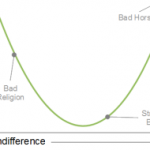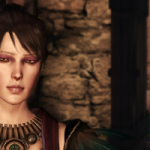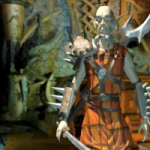Less Flicks More Bits
April 5, 2010 - Features
The indie developer Craig “Superbrothers” Adams recently published a manifesto called “Less Talk More Rock,” based on a talk he gave at the Game Developer’s Conference. It is a good and glorious thing that we have finally reached the “artistic manifesto” phase in the development of the videogame medium; let us rejoice and hope for more to come.
Adams’s piece starts with some very sensible-sounding advice on the game development process and then makes a more interesting turn into recommendations on game style. The gist of the thing is that Adams feels that the native language of videogames is audiovisual; that excessive use of written or spoken text in games engages too much of the intellectual rather than the more holistic parts of the brain; and therefore that text in games disrupts the natural communication between designer and player. I think all of these points are highly debatable, but the one I want to push back against the most is the first one.
The Native Language of Games Is Audiovisual?
Adams argues against game designers leaning on the traditional medium of text to the point of neglecting the possibilities of the new medium of games, which is grand. But by emphasizing the audiovisual aspect of games so prominently, he seemingly ends up arguing that designers lean instead on the slightly less traditional medium of film.
Since when did audiovisual output have a privileged place in videogames? Is a tabletop RPG with barely any audiovisual components really a completely different type of thing than a computer RPG? Is that computer RPG more similar to a movie than to the tabletop game? Or to a text-based MUD with nearly identical underlying mechanics? I mean, if you ask me which of these things is not like the others…




…how they look and sound is not going to be the first thing on my mind. If that were the case, I’d group the movie and the good graphics game together, sure. But are we really willing to say that Dragon Age, as an experience, is more like a Lord of the Rings movie than it is like Dungeons and Dragons? More importantly, if we go down that road, what does that say about what we value in Dragon Age?
The thing is, this is the line of thinking that leads to the Roger Ebert Fallacy. Ebert has famously argued that games cannot be art because they do not allow for authorial control. That is, you can’t apply critical judgement to a something if the story is different every time someone experiences it, because there is no single, stable creation to appreciate or analyze. The viewer takes over for the author and makes a new creation every time she plays.
The reason that Ebert makes this argument, I imagine, is that he lives and breathes movies, so when he sees a videogame he naturally tends to focus on the part that looks like a movie, i.e., the audiovisual output. And if you think of this audiovisual output as what the game is, then yes, the “game” is obviously a different thing every time it is played. There is no authorial control, no stable artistic experience being created, no “text” for a critic to analyze or dive into. Just a bunch of more-or-less similar movies with terrible cinematography.
But a game is not a bunch of movies, because any given audiovisual experience is not what the game is. When I talk to a friend about Dragon Age, we’re talking about two radically dissimilar audiovisual experiences, but we’re talking about the same game. Which is to say something pretty obvious but not always stated outright:
The Native Language of Games Is Software!
Videogames are art made out of code. The reason we’re all talking about the same thing when we talk about Dragon Age is that we’re all talking about the same executable piece of software. The author of a game does not create an audiovisual experience, as Ebert assumes. The author of a game creates a piece of software. That software can be interacted with in a number of different ways. In some cases it can be executed on a number of different hardware setups, including a bunch of guys with dice, pens, and paper. It’s just a set of rules.
Some of those rules may include instructions for displaying the state of the game in a graphical interface. These graphical interfaces can be pretty bare bones, or they can be thrilling sensory experiences in and of themselves. They are optional.
The Ebert Fallacy arises from treating the output of this graphical interface as the artist’s primary creation, rather than the software. The software, unlike the audiovisual output, is a stable and singular text which can be subject to critical analysis and artistic appreciation. Treating the audiovisual as the core aspect of a game makes it easy to ignore how much authorial control goes into crafting this text.
Of course, there’s a reason this happens so often with games. We rarely get to see the code in its raw form, and even if we did, only programmers would understand it.* The audiovisual stuff is right there in front of you. But the audiovisual stuff is just there to tell you where you are in the software. You figure out the shape and feel and experience of that software by exploring it through the interface, whatever that is. Your exploration is your own. It is how you learn about the game; it is not the game itself.
To get back to “Less Talk More Rock,” I’m not saying Adams is making this mistake. He’s just arguing for a more sensuous and unintellectual style of game design. But in doing so he gives image and sound an elevated status over verbal communication, which I think is a problem. Neither are the native language of games. The native language of games is code: rules, mechanics, and instructions. And because this native language is so crazily, bracingly abstract, games will always need to merge with some other form of communication just to let you know what’s going on.
You make that communication primarily audiovisual, you get one style of game. You make it primarily verbal, you get another style. You mix the two, you get something else. None of these styles is pure. And they certainly don’t encompass all possibilities.
* Note to programmers: obviously I’m being facetious. Other people’s code is always unreadable and in most cases clear evidence of a dangerously unbalanced mind.


